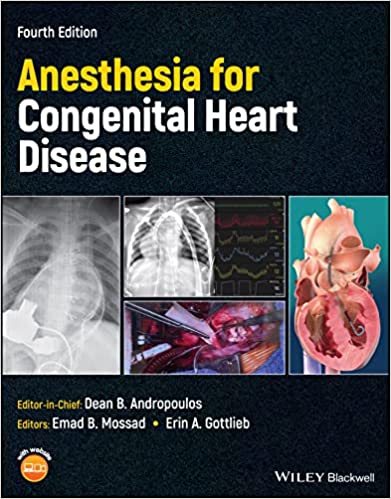
Edition 4 (2023)
Dean Andropoulos, Emad Mossad, Erin Gottlieb
An Extensive Reference Work Detailing the Procedures, Knowledge, and Approaches in Anesthesia for Congenital Heart Disease
In the 4th edition of Anesthesia for Congenital Heart Disease, a distinguished group of expert authors in congenital heart disease from all over the world provide a thorough, comprehensive and fully updated overview of the specifics of congenital heart disease (CHD), and the intricacies involved with administering anesthetic care to patients who suffer from the myriad of lesions encompassed by CHD.
In the seven years since the 3rd Edition of Anesthesia for Congenital Heart Disease was published, an explosion of new procedures, approaches, and patients eligible for anesthetic care has occurred. The goal of Anesthesia for Congenital Heart Disease, Fourth Edition is to help readers understand all of the recent advancements and developments in the field while also imparting a foundation of essential historical knowledge. The book contains new chapters that reflect exciting new approaches in this rapidly changing field, and also includes:
Updated information in the chapter Adult Congenital Heart Disease and Mechanical Support of the Circulation, reflecting the increasing prominence of these patients in CHD care
New chapters on Informatics and Artificial Intelligence, Genetic Syndromes, Point of Care Ultrasound, and Cardiopulmonary Resuscitation in Congenital Heart Disease
Thorough updates of all chapters with many new figures and tables, and hundreds of new recent references provide up to date information
Anesthesia for Congenital Heart Disease, Fourth Edition serves as a thorough and in-depth reference work and is an essential resource for practitioners providing perioperative care to CHD patients.
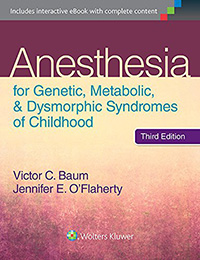
Edition 3 (2015)
Victor Baum, Jennifer O'Flaherty
Using a quick-reference, encyclopedic format, Anesthesia for Genetic, Metabolic, and Dysmorphic Syndromes of Childhood, 3rd Edition, presents the anesthetic implications of a plethora of distinct syndromes, with up-to-date information, complete and current bibliographies, and more than 140 clinical photographs. You’ll find practical information on common and uncommon manifestations in the major anatomic areas, as well as what you need to know for safe and effective anesthesia of both children and adults.
Key Features:
Presents each syndrome in an easy-to-follow format: name, synonym(s), and common and uncommon manifestations in each organ system, followed by anesthetic considerations, including which syndromes have no anesthetic implications.
Lists syndromes and synonyms alphabetically, and cross-references synonyms for quick look-up.
Incorporates an overview of the pathology and relevant clinical findings for each syndrome, and highlights considerations in perioperative management.
Features a helpful glossary at the beginning of the book, as well as diagrams that review pertinent biochemical pathways.
Now with the print edition, enjoy the bundled interactive eBook edition, offering tablet, smartphone, or online access to:
Complete content with enhanced navigation
Powerful search tools and smart navigation cross-links that pull results from content in the book, your notes, and even the web
Cross-linked pages, references, and more for easy navigation
Highlighting tool for easier reference of key content throughout the text
Ability to take and share notes with friends and colleagues
Quick reference tabbing to save your favorite content for future use
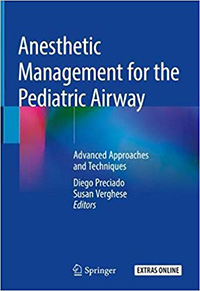
Edition 1 (2019)
Diego Preciado, Susan Verghese
The advancement of tactics used in managing pediatric airway disorders can be attributed to an overall growth of collective knowledge among medical health professionals. This book is designed to sustain that growth of knowledge, with 18 chapters of insight and information by distinguished medical experts in both pediatric anesthesia and pediatric otolaryngology. It concisely and thoroughly covers topics such as subglottic stenosis, pharyngeal airway obstruction, laryngeal airway obstruction, obesity and sleep apnea and thoracic airway obstruction, among others. Chapters include scenarios where the skills and expertise of both anesthesiologists and otolaryngologists are being continually tested; the use of newer drugs and repurposing of older drugs; the combination of smaller amounts of different types of sedatives while avoiding intra-op narcotics and maintaining spontaneous ventilation are described in detail; Finally, a comprehensive review of new research emerging about ultra-rapid narcotics metabolizers among patients, making them more susceptible to medications, such as codeine, along with the latest information on the purported potential neurodevelopmental toxicity of some anesthetic agents are also included. Working as both an educational tool and a practical resource, medical practitioners, students and educators will find this text to be a valuable tool for the safely managing the pediatric patient undergoing anesthesia for difficult airway scenarios.
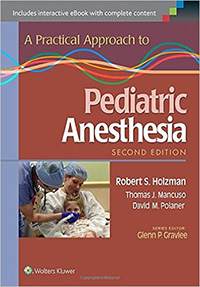
Edition 2 (2015)
Robert Holzman, Thomas Mancuso, David Polaner
Part of the highly popular Practical Approach to Anesthesia series, this new edition combines the comprehensive depth of a textbook and the user-friendly features of a practical handbook. Focusing on clinical issues in pediatric anesthesia, it contains the in-depth information you need for daily practice and study, presented in a concise, bulleted format for quick reference. With its emphasis on developmental aspects of pediatric anesthesia, numerous illustrations and tables, and methodical approach to decision making, this updated reference is an invaluable resource for anyone involved with anesthesia of children.
Key Features
Features new chapters on vascular biology and vascular anomalies, healing and recovery in pediatric surgery, and training and education in pediatric anesthesia. All existing chapters have been fully updated to keep you up to date.
Covers key issues of growth and development – anatomic, physiologic, and pharmacologic – that form the basis for a better understanding of pediatric anesthesia.
Discusses the approach to the pediatric patient, clinical and operational aspects of pediatric anesthesia, anesthetic management of normalities and abnormalities of each organ system, and special situations such as fetal surgery, anesthesia outside the operating room, and trauma.
Provides a clear understanding of anomalies, embryology, anatomy, and surgery so that you’re well prepared to choose the best induction, maintenance, and emergence techniques, as well as make informed monitoring and equipment decisions.
Presents information in a bulleted, outline format for easy reference and review.
Now with the print edition, enjoy the bundled interactive eBook edition, which can be downloaded to your tablet and smartphone or accessed online and includes features like:
Complete content with enhanced navigation
Powerful search tools and smart navigation cross-links that pull results from content in the book, your notes, and even the web
Cross-linked pages, references, and more for easy navigation
Highlighting tool for easier reference of key content throughout the text
Ability to take and share notes with friends and colleagues
Quick reference tabbing to save your favorite content for future use
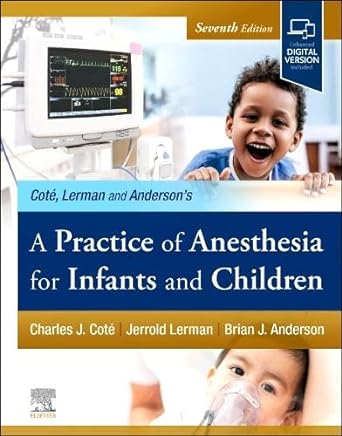
Edition 7 (2024)
Charles Cote, Jerrold Lerman, Brian Anderson
Covering everything from preoperative evaluation to neonatal emergencies to the PACU, Coté, Lerman and Anderson’s A Practice of Anesthesia in Infants and Children, 7th Edition, features state-of-the-art advice on the safe, effective administration of general and regional anesthesia and sedation strategies for young patients. This text reviews underlying scientific information, addresses preoperative assessment and anesthesia management in detail, and provides guidelines for postoperative care, emergencies, and special procedures. Comprehensive in scope and thoroughly up to date, this edition delivers unsurpassed coverage of every key aspect of pediatric anesthesia.
Presents must-know information on standards, techniques, and the latest advances in pediatric anesthesia from global experts in the field.
Contains thoroughly updated content throughout, with new contributors to lend a fresh perspective, updated figures and tables, and the latest information on perioperative fluid management, pharmacology, interventional devices, resuscitation, and more.
Covers key topics such as anesthetizing children with cancer, neonatal and pediatric emergencies, the obese child and bariatric surgery, interventional devices for children with congenital heart defects, cardiopulmonary resuscitation, simulation in pediatric anesthesia, patient safety and quality assurance, and more.
Features an extensive video library of pediatric anesthesia procedures, particularly difficult airway management strategies, new positioning devices, cardiac assist devices in action, management of burn injuries, how to perform ultrasound-guided regional anesthesia blocks and techniques, and much more.
Essentials chapters provide focused input from expert subspecialty pediatricians who share the latest information concerning hematology, pulmonology, oncology, hepatology, nephrology, and neurology.
Includes a laminated pocket reference guide with essential, practical information, and key references at the end of each chapter that provide a quick summary for review. An extended online version is available in the app (“Pedi Anesth”; Starship Children’s Hospital, Auckland District Health Board, NZ).
An eBook version is included with purchase. The eBook allows you to access all of the text, figures, and references, with the ability to search, customize your content, make notes and highlights, and have content read aloud. Any additional digital ancillary content may publish up to 6 weeks following the publication date.
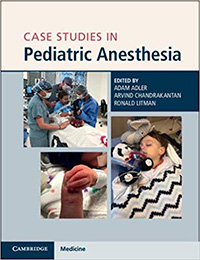
Edition 1 (2019)
Adam Adler, Arvind Chandrakantan, Ronald Litman
Pediatric anesthesiologists will encounter numerous challenges when caring for children as their work involves more than simply adjusting drug dosages and equipment for smaller patients. In response, this practical book provides clinical guidance in an easily-accessible and digestible question-answer format. Case Studies in Pediatric Anesthesia reviews the entire breadth of pediatric anesthesia and pain management, taking a case-based approach. Each chapter commences with a clinical case or scenario, guiding the reader through a tailored discussion. The chapters review the pathophysiology, anesthetic techniques and surgical and perioperative considerations. High quality tables and figures feature throughout to help solidify key concepts. The chapters are prepared to be read in isolation and for reference when appropriate. Case Studies in Pediatric Anesthesia is aimed at anesthesiologists of all levels, from the trainee on their first pediatric rotation, to the pediatric fellow preparing for boards examination to the seasoned clinician.
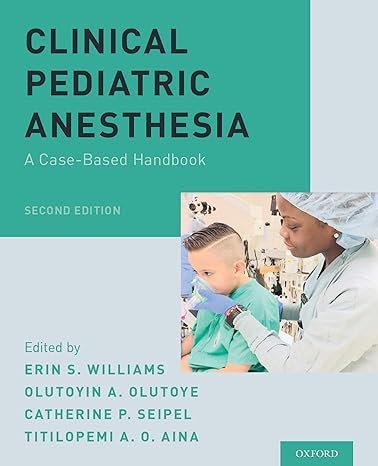
Edition 2 (2018)
Erin Williams, Olutoyin Olutoye, Catherine Seipel, Titilopemi Aina
This second edition of Clinical Pediatric Anesthesia: A Case-Based Handbook offers a comprehensive review of the options, advantanges, and disadvantages of different aspects of the perioperative management of the pediatric patient, as well as examples of a wide range of relevant clinical scenarios. Chapters are organized into 15 sections and cover the field of pediatric anesthesiology with a point-of-care approach. Written by a team of over 50 Pediatric Anesthesiologists at tertiary children's hospitals, this highly accessible text provides readers with multiple approaches to the anesthetic care of the pediatric patient. Each chapter includes an introduction to the topic, followed by learning objectives, clinical vignettes, and a discussion section styled in a question-and-answer format, concluding with a summary of the highest-yield and most salient information. Chapters also provide annotated references and suggestions for further reading to facilitate in-depth study of topic. The variety of cases presented, along with the contributors' expertise, render valuable real-life clinical situations that promote critical thinking and evaluation necessary for all pediatric anesthesiology consultants.
Edition 1 (2019)
Kai Matthes, Herodotus Ellinas
A new textbook of pediatric anesthesiology – modeled after the bestselling Morgan and Mikhail’s Clinical Anesthesiology
Filling a void in the anesthesiology literature, this new text delivers streamlined yet comprehensive discussion of the unique aspects and considerations necessary to successfully manage pediatric patients.
For each procedure covered, there is a review of equipment, technique, alternatives, and ways to manage complications or troubleshoot errors. A complete multi-media resource, LANGE Clinical Pediatric Anesthesiology includes a link to 50 videos depicting key pediatric anesthetic procedures. This unique resource is ideal for trainees and practitioners who have limited time and need a solution to a specific clinical problem. Sections include: Basic Science, Pharmacology, Anesthetic Practice, Procedures, and Special Considerations.
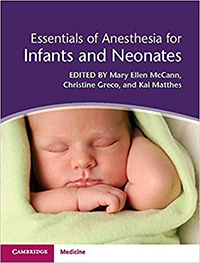
Edition 1 (2018)
Mary Ellen McCann, Christine Greco, Kai Matthes
It is estimated that 1.5 million infants undergo surgery and anesthesia in the USA each year. However, there are serious concerns within the pediatric anesthesia community regarding the safety of anaesthesia in infants and children. There is mounting evidence from animal studies that anesthetics in common clinical use are neurotoxic to the developing brain and cause long-term neurobehavioral abnormalities. Essentials of Anesthesia for Infants and Neonates provides a comprehensive guide to the special needs of infants undergoing anesthesia. It focuses on the first year of life, the time when anesthesia mortality and morbidity is highest. Chapters are illustrated in color throughout, and include sections on newborn physiology for anesthetic management, specific procedures, pain management, and topics such as regional anesthesia and sedation. Written by nationally recognized experts, this book will become an invaluable point of reference for any physician interested in pain management in the first year of life.
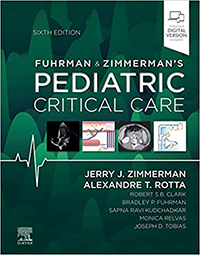
Edition 6 (2021)
Jerry Zimmerman, Alexandre Rotta
In the highly specialized field of caring for children in the PICU, Fuhrman and Zimmerman's Pediatric Critical Care is the definitive reference for all members of the pediatric intensive care team. Drs. Jerry J. Zimmerman and Alexandre T. Rotta, along with an expert team of editors and contributors from around the world, have carefully updated the 6th Edition of this highly regarded text to bring you the most authoritative and useful information on today’s pediatric critical care―everything from basic science to clinical applications
Contains highly readable, concise chapters with hundreds of useful photos, diagrams, algorithms, and clinical pearls.
Uses a clear, logical, organ-system approach that allows you to focus on the development, function, and treatment of a wide range of disease entities.
Features more international authors and expanded coverage of global topics including pandemics, sepsis treatment in underserved communities, specific global health concerns by region.
Covers current trends in sepsis-related mortality and acute care after sepsis, as well as new device applications for pediatric patients.
Provides ultrasound videos and more than 500 board-style review questions and answers on Expert Consult.
Enhanced eBook version included with purchase. Your enhanced eBook allows you to access all of the text, figures, and references from the book on a variety of devices.
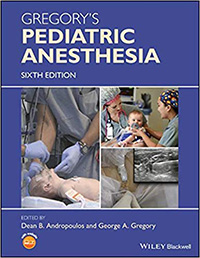
Edition 6 (2020)
George Gregory, Dean Andropoulos
As the field pediatric anesthesia advances and expands, so too does the gamut of challenges that are faced by today’s anesthesiologists. Gregory’s Pediatric Anesthesia aims to fully prepare trainees and experienced professionals for modern practice by equipping them with the knowledge and cutting-edge techniques necessary to safely and successfully anesthetize children for a range of different surgeries and other procedures. Supporting their work with current data and evidence, the authors explore topics including basic principles, potential complications, and best practice, and illustrate their findings with detailed case studies that cover all major subspecialties.
This essential new edition includes access to illustrative videos and features new and expanded sections, such as:
Anesthesia for Spinal Surgery complications including postoperative blindness
Robotic surgery for Pediatric Urological Procedures
Anesthesia for Non-Cardiac Surgery in Patients with Congenital Heart Disease (new chapter)
Extensive additional ultrasound images for regional anesthesia
Neonatal Resuscitation
The Pediatric Surgical Home and Enhanced Recovery after Surgery (new chapter)
Now in its sixth edition, Gregory’s Pediatric Anesthesia continues to provide reliable and easy-to-follow guidance to all anesthesiologists caring for younger patients.
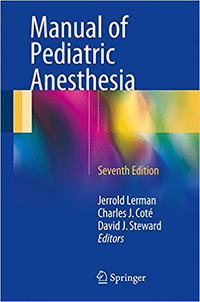
Edition 7 (2016)
Jerrold Lerman, David Steward, Charles Cote
Authored by three world experts, this is a clinically focused book on pediatric anesthesia. "The Manual", as it is known, has long dominated the market for a succinct and practical resource on administering anesthesia to children and is used by residents, general anesthesiologists, nurse anesthetists, and pediatric anesthesiologists. This new edition retains the basic structure of the book and is updated throughout. Text-heavy in the current edition, the Seventh Edition features the addition of figures to chapters where they are especially helpful (eg, the chapter on cardiovascular surgery and cardiac procedures) and makes greater use of headings to break up the text and guide reading. From reviews of the Sixth Edition:"This is an extremely well written book that I would recommend highly to anyone involved in anaesthetizing children. It is comprehensive enough to provide an excellent reference for trainees and general anaesthetists who occasionally deal with paediatric cases, while at the same time giving valuable supplemental information for paediatric anaesthetists encountering an unusual procedure or condition. In short, this is a book that would make a welcome addition to any anaesthetist's mobile library." --Anaesthesia
Edition 1 (2015)
T. Anthony Anderson, Kai Matthes, Anjolie Laubach, Ellen Wang
Pediatric Anesthesiology: A Comprehensive Board Review is a high-yield, streamlined study aid. It contains more than 800, realistic, multiple-choice questions tailored to the keywords in the outline of the Pediatric Anesthesiology Certification Examination published by the American Board of Anesthesiology (ABA). To maximize reading efficiency, annotated answers are followed by bulleted key facts and key references. With this book as guide, readers will be able to efficiently prepare for the written primary certification pediatric anesthesiology board exam.
Edition 3 (2021)
Robert Holzman, Thomas Mancuso, Joseph Cravero, James DiNardo
This book functions as a workbook for consultants in pediatric anesthesia. Based on a curriculum developed at the Boston Children’s Hospital Department of Anesthesiology, the content illustrates the breadth and depth of the practice of pediatric anesthesia.
Organized into two parts, the book seeks to provide a sense of progression and feedback using clinical scenarios to aid the medical professional in developing autonomy, while preserving the availability of expert level discussion. Each chapter features self-assessments in question and answer format, and encourages the reader to be creative in their responses by invoking not only their clinical knowledge, but their philosophical views of pediatric anesthesia practice as well.
Practical and accessible, The Pediatric Anesthesiology Review is an essential resource for those looking to attain proficiency, expertise, and mastery in pediatric anesthesiology.
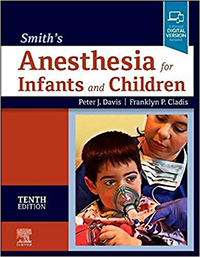
Edition 10 (2021)
Peter Davis, Franklyn Cladis
Written and edited by renowned experts in pediatric anesthesia, Smith's Anesthesia for Infants and Children provides clear, concise guidance on effective perioperative care for any type of pediatric surgery. The 10th Edition contains significantly revised content throughout, bringing you fully up to date with recent advances in clinical and basic science that have led to changes in today’s clinical practice.
Offers comprehensive coverage of physiology, pharmacology, and clinical anesthetic management of infants and children of all ages.
Contains new chapters on Airway Physiology and Development, Normal and Difficult Airway Management, Ultrasound, Acute Pain Management, Chronic Pain Management, Palliative Pain Management, Infectious Diseases, and Education; plus extensively revised content on cardiovascular physiology; induction, maintenance, and recovery; organ transplantation, and more.
Features more than 100 video demonstrations, including regional anesthesia videos, echocardiograms of congenital heart lesions, anatomic dissections of various congenital heart specimens with audio explanations, various pediatric surgical operative procedures, airway management, and much more.
Provides outstanding visual guidance throughout, including full-color photographs, drawings, graphs and charts, and radiographic images.
Includes quick-reference appendices online: drug dosages, growth curves, normal values for pulmonary function tests, and a listing of common and uncommon syndromes.
Provides an interactive question bank online for review and self-assessment.
Enhanced eBook version included with purchase. Your enhanced eBook allows you to access all of the text, figures, and references from the book on a variety of devices.
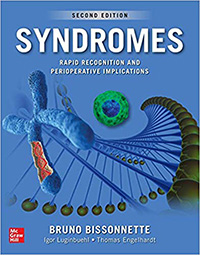
Edition 2 (2019)
Bruno Bissonnette, Igor Luginbuehl, Thomas Engelhardt
Your one-stop resource for all major genetic syndromes and important anesthetic, diagnostic, and pharmacological considerations
4 STAR DOODY'S REVIEW!
"This is a nearly exhaustive compilation of over 4,500 pediatric syndromes and their impact on perioperative management....I have not come across a book that covers this subject as completely and makes referencing as easy as this one does. It is truly an essential text for those providing operative care to children who have syndromic diseases."--Doody's Review Service
The ultimate desk reference for anesthesiologists, pediatricians, geneticists, and internists, Syndromes provides convenient A-Z coverage of more than 2,000 genetic, metabolic, and dysmorphic conditions. Extensive cross-referencing of synonyms, variations, and international names leads to over 4,500 entries in all!.
An encyclopedic dictionary of every genetic syndrom known to humankind
Includes synonyms, variations and international names--more than 4,500 cross-referenced syndromes in all
180 photographs illustrate manifestations and common presentations
Standardized, two-column rapid retrieval template
For each syndrome, from Aarskog to Zellweger Syndrome, you'll find a succinct "snapshot" of clinical information that includes:
"At a Glance" Description
Incidence
Genetic Inheritance
Pathophysiology
Diagnosis
Clinical Aspects
Precautions before Anesthesia
Anesthetic Considerations
Pharmacological Implications
Other Conditions to be Considered
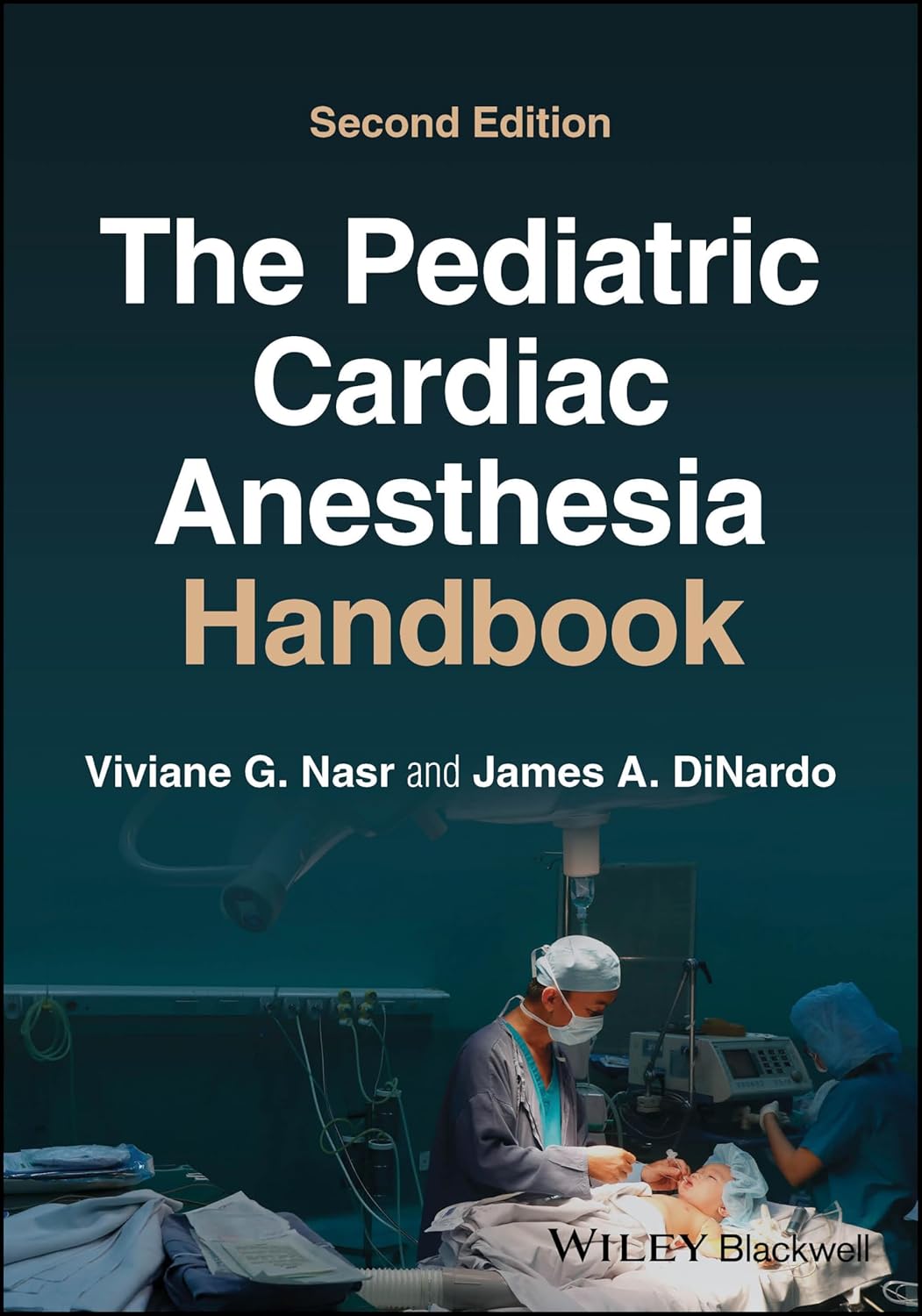
Edition 2 (2025)
Viviane Nasr, James DiNardo
A concise yet comprehensive overview of the anesthetic management of pediatric patients with congenital heart disease
Designed for ease of use, The Pediatric Cardiac Anesthesia Handbook is divided into two parts: Part One covers the basic assessment of patients, including cardiovascular physiology, the pathophysiology of coronary heart disease, preoperative evaluation, intraoperative management, and interpretation of cardiac catheterization data. Part Two contains templated chapters that address a variety of disorders, allowing easy reference to anatomical and physiological features, surgical therapies, anesthetic approach, and postoperative management.
Now in its second edition, The Pediatric Cardiac Anesthesia Handbook contains new chapters on coagulation and blood management, echocardiography, risk scoring systems, and postoperative critical care management, as well as a completely revised chapter on mechanical circulatory support.
Providing clear and reliable, this easily referable pocket-sized resource:
Addresses the additional complexities of pediatric patients and the anesthetic considerations for non-cardiac surgery after heart and heart-lung transplantation
Provides guidelines on specific lesions for the pediatric anesthesiologist caring for cardiac patients presenting for non-cardiac surgery
Contains templated chapters that allow easy reference by members of the multidisciplinary team, such as cardiologists, cardiac intensivists, perfusionists, and surgeons
Features high-quality illustrative echocardiographic images in every chapter and bulleted content designed for rapid reference
Written by an expert author team at the world-renowned Boston Children’s Hospital, The Pediatric Cardiac Anesthesia Handbook is a must-have guide and study aid for anesthesiology and cardiac critical care trainees and practitioners who manage patients with congenital heart disease.

